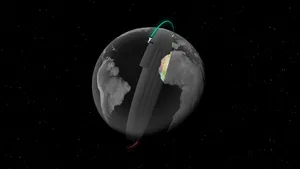Check out the first images of wildfires detected by FireSat
FireSat is equipped with a custom Mid-Wave Infrared (MWIR) sensor that detected a small, relatively cool roadside fire near Medford, Oregon last month. This fire was not detected by other space-based systems. It’s seen here overlaid on a Google Earth basemap.
Credit: Muon Space and Earth Fire Alliance.
FireSat can provide comprehensive insights throughout a wildfire’s lifecycle as seen in this image of the Nipigon 6 fire in Ontario, Canada, on June 15, 2025, showing both active fires and a previous scar from a 2020 fire. Top: FireSat's Mid-Wave Infrared (MWIR) channel identifies active fire regions as bright spots. Middle: The Long-Wave Infrared (LWIR) channel highlights a range of heat sensing, including intense active flames to the east of Petawanga Lake and the burn scar from a September 2020 fire being warmed by the sun west of the lake–burn scars are often warmer than surrounding areas due to a lack of vegetation. Bottom: The false-color composite using Short-Wave Infrared (SWIR), Near-Infrared (NIR), and visible Red channels reveals both burn scars–the one from 2020 in rust tones and the current fire in purple.
Credit: Muon Space and Earth Fire Alliance.
FireSat can detect multiple simultaneous wildfires across large landscapes to enable coordinated response efforts. Multiple active fires were detected near Borroloola, Northern Territory, Australia, on July 11, 2025. FireSat’s Mid-Wave Infrared (MWIR) channel identified a number of active fire areas and burning fire fronts scattered throughout the region. Both the MWIR and Long-Wave Infrared (LWIR) channels reveal variations in surface temperatures across the landscape, providing environmental context alongside precise fire detection.
Credit: Muon Space and Earth Fire Alliance.
FireSat can provide critical near-real time wildfire monitoring in remote regions where ground-based observation can be difficult to achieve, like in Alaska where the terrain is often inaccessible and extremely challenging to monitor for wildfires. FireSat captured two remote Alaskan wildfires in one image on June 21, 2025: the Moran Fire, located 27 miles northwest of Tanana; and the Chicken Fire, 12 miles west of Kallands. FireSat's Mid-Wave Infrared (MWIR) channel reveals both active fire fronts, demonstrating FireSat's ability to simultaneously monitor multiple wildfire events.
Credit: Muon Space and Earth Fire Alliance.
Today, in partnership with the Earth Fire Alliance and Muon Space, we shared the first images of wildfires detected by FireSat, a revolutionary new satellite constellation purpose-built to detect and monitor wildfires on a global scale. This marks an important milestone in the ongoing work from Google Research to develop AI-powered tools to protect communities and ecosystems worldwide.
FireSat was designed to create a dataset that transforms how devastating fires are managed. The infrared sensors on the satellite are specifically designed to peer through smoke, and provide accurate, near real-time tracking of fast-evolving fires.
In the first images, FireSat detected a small Oregon fire that went undetected by existing satellite systems. The FireSat constellation will be able to see fires as small as 5x5 meters — which is significantly more powerful than current real-time systems! Once fully operational, the constellation will scan every point of the Earth within 20 minutes, enabling faster fire detection and response.






